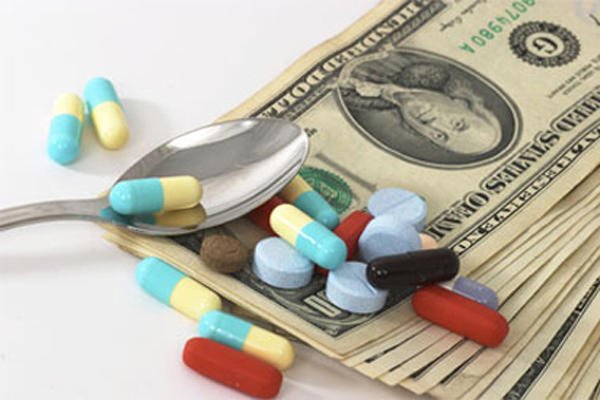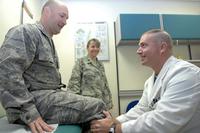 Military Update: The Department of Defense pharmacy program is on to track to slice $1.3 billion off projected drug costs from 2014 to 2019, thanks to higher beneficiary co-pays, tighter point-of-service rules and recent streamlining of prescription drug processes across the military, explained Dr. George E. Jones, chief of pharmacy operations for the Defense Health Agency (DHA).
Military Update: The Department of Defense pharmacy program is on to track to slice $1.3 billion off projected drug costs from 2014 to 2019, thanks to higher beneficiary co-pays, tighter point-of-service rules and recent streamlining of prescription drug processes across the military, explained Dr. George E. Jones, chief of pharmacy operations for the Defense Health Agency (DHA).
One of the more surprising aspects of savings being captured, said Jones, is that average annual out-of-pocket costs for beneficiaries have stayed flat or even fallen, despite recent increases in drug co-payments.
That’s because changes to law and policy have forced or enticed beneficiaries to use more efficient points of service than retail outlets. Those who need maintenance drugs for chronic conditions must now use mail order where refills are for three months for the same or smaller co-pay than charged for a month of pills at retail. Also base pharmacies, where drugs are still dispensed free of charge, have expanded their formularies, or drugs they must stock, to better support nearby beneficiaries.
Despite a couple of co-pay increases the past five years to encourage beneficiaries to use generic medicines and more cost-efficient drug outlets, the average annual out-of-pocket cost per beneficiary has ranged from $553 to $603 with the lowest figure reported most recently, for fiscal 2016.
“That is a lot of prescriptions moving from 30-day supplies to 90-day supplies at [military treatment facilities] and mail order,” Jones said. Prescriptions filled at retail are more expensive for the department. So it is seen as good news that, from 2012 through 2016, DoD drug spending at TRICARE retail outlets fell by $956 million while it rose by $1.47 billion at mail orders and by $94 million across base pharmacies.
Jones called it a “win-win for the patient and the government.” He credited Congress for creating “the framework for us to execute initiatives to ensure beneficiaries understand their options on keeping out-of-pocket costs low and [getting] best service.”
The big move was requiring beneficiaries who want brand name maintenance drugs to get them via home delivery or on base, ending their availability at retail pharmacies unless beneficiaries pay the full cost.
“Our contract partner, Express Scripts Inc., has been vital to this part of the overall success of the program,” Jones said. “They have facilitated a relatively smooth implementation of this guidance with a structure and communication outreach that has made it fairly straight forward, simple and smooth for patients to utilize [base pharmacies] and mail order.”
In fiscal 2016, military pharmacy costs totaled $9.5 billion, the lowest since 2010. Jones cautioned that three quarters of the $2.1 billion drop from 2015 reflected a successful crackdown on fraud and abuse directed at TRICARE by compound drug schemes. But ignoring the $1.6 billion compound drug tab in 2015, drug costs still fell in 2016 by $500 million.
Besides higher co-pays to change behavior and restrictions on brand name maintenance drugs at retail, base pharmacies expanded their drug formularies “to ensure they are taking care of their enrolled populations,” Jones said. Both Express Scripts and DHA helped them do so with drug usage data to better serve beneficiaries and recapture business.
These and more initiatives are part of a larger effort by the three-year-old DHA to integrate and optimize the pharmacy benefit using new authorities, Jones noted during an hour-long presentation this month at the annual conference of AMSUS, the Society of Federal Health Professionals.
The recent co-pays that he credited with helping to shape beneficiary behavior did not include far higher prescription co-pays sought by DoD as part of the fiscal 2017 defense authorization bill. Earlier this year, the Senate had approved the plan to raise beneficiary out of pockets sharply. But House-Senate conferees rejected them, for now, as they ironed out final differences between separate versions of the defense policy bill.
So DHA’s projection of $1.3 billion in savings on drug costs through fiscal 2019 still stands. It’s being achieved even as pharmacy usage per beneficiary rises, largely because beneficiaries are making better choices, Jones said. The migration back to base pharmacies got a boost when they acquired the ability to fill prescriptions from physicians electronically, just as many retail outlets have done for years. E-prescriptions not only make dispensing prescriptions easier, Jones said, but patient safety is enhanced.
After e-prescribing became standard in civilian communities but still not on bases, civilian physicians serving TRICARE realized they could only send e-prescriptions to retail outlets and did so -- even when base pharmacies were nearer, had the drug in stock and charged no co-pay.
“Now those prescriptions are coming back to military treatment facilities,” Jones said. “As of January 2016, which was the one-year anniversary of starting this initiative, over two million prescriptions had come back to [base] via electronic prescribing.”
DHA began to refer to the pharmacy program as an “enterprise” as it assumed greater oversight for controlling drug costs and improving the beneficiary experience across the entire military. But Jones emphasized that streamlining of the enterprise has relied on a Pharmacy Working Group comprised of Army, Navy, Air Force, Coast Guard and DHA representatives.
They have implemented a unified set of business rules to guide and execute department-wide drug policies. They have aligned metrics to measure performance in delivering the benefit, and aligned incentives to drive beneficiary behavior toward cost-effective decisions, Jones said.
Of 9.4 million beneficiaries eligible to the use the pharmacy benefit, 82 percent did so in fiscal 2016. That was up from 66 percent in 2002, before the TRICARE mail order program began. A total of 7.7 million beneficiaries got at least one prescription filled in 2016, two million more than in 2002. Prescriptions filled across all three points of service totaled 127 million in 2016 versus 82 million in 2002, a 55 percent jump.
Almost 60 percent of beneficiaries are retirees or their family members: 3.1 million (33.2 percent) are retirees 65 and older and their dependents; 2.2 million (23.7 percent) are younger retirees and their family members. About 1.5 million beneficiaries (16.4 percent) are active duty and two million (21.4 percent) are family members of active duty.
The remaining half million “other” beneficiaries are mostly Reserve, Guard and their family members who qualify for the drug benefit.
Send comments to Military Update, P.O. Box 231111, Centreville, VA, 20120, email milupdate@aol.com or twitter: Tom Philpott @Military_Update.
# # # #
Tom Philpott has been breaking news for and about military people since 1977. After service in the Coast Guard, and 17 years as a reporter and senior editor with Army Times Publishing Company, Tom launched "Military Update," his syndicated weekly news column, in 1994. "Military Update" features timely news and analysis on issues affecting active duty members, reservists, retirees and their families.
Visit Tom Philpott's Military Update Archive to view his past articles.
Tom also edits a reader reaction column, "Military Forum." The online "home" for both features is Military.com.
 Tom's freelance articles have appeared in numerous magazines including The New Yorker, Reader's Digest and Washingtonian.
Tom's freelance articles have appeared in numerous magazines including The New Yorker, Reader's Digest and Washingtonian.
His critically-acclaimed book, Glory Denied, on the extraordinary ordeal and heroism of Col. Floyd "Jim" Thompson, the longest-held prisoner of war in American history, is available in hardcover and paperback.




